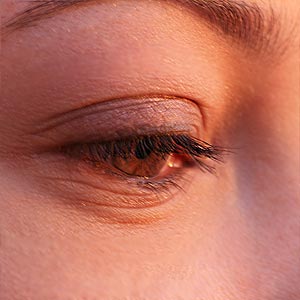Skin Cancer Symptom

Skin Cancer, the most common of all human cancers develops due to the uncontrolled growth of skin cells. These uncontrolled cells form tumors or lesions. All lesions or tumors are not cancerous. They are cancerous only if they invade the neighboring tissues because of their unrestrained growth.
Basal cell carcinoma is the most common form of skin cancer and accounts for more than 90 percent of all skin cancer in the U.S. A large portion of non-melanoma skin cancer diagnosed yearly in the United States is related to sun exposure.
Types of Skin Cancer
Human skin consists of two main layers and several kinds of cells. The top layer of skin is called the epidermis. It contains three kinds of cell s- flat, scaly cells on the surface (Squamous cells), round cells (basal cells) and cells that impart skin its color (melanocytes). Skin cancers are often divided into two categories - the melanoma skin cancer and the non-melanoma skin cancer.
Non-melanoma Skin Cancer
Non-melanoma skin cancers are further classified as basal cell carcinomas and Squamous cell carcinoma. Most non-melanoma skin cancers develop on sun-exposed areas of the body like the face, ear, neck, lips and the backs of the hands. Basal cells are located at the base of the outer layer of the skin and cover the internal and external surfaces of the body.
These cancer cells enlarge slowly and steadily. Basal cell cancers can also invade neighboring tissue like the eye. However, these cells do not spread to distant parts of the body. Basal cell carcinoma is probably one of the most common type of skin cancer. Squamous cell carcinoma is the second most common skin cancer after basal cell carcinoma.
It arises from the epidermis and resembles the Squamous cells that comprise most of the upper layers of the skin. Squamous cell cancers may occur on all areas of the body including mucous membranes, but are most common in areas exposed to sun. Overexposure to the sun and other sources of light such as sunlamps and tanning booths are the major reasons for non-melanoma skin cancers.
Melanoma Skin Cancer
Melanoma is a cancer that develops in the melanocytes - the cells that produce the skin coloring pigment known as melanin. Melanin helps protect the deeper layers of the skin from the harmful effects of the sun. Melanoma is most commonly found in adults though some children and adolescents occasionally develop it.
Melanoma is a serious type of cancer that necessitates immediate medical attention should you notice any symptoms of it. Melanoma cancer cells are metastasize cells and they rapidly spread to other parts of the body through lymph system or through blood. Melanoma is the leading cause of death from skin disease.
- Change in the size, shape, or color of a mole
- Oozing or bleeding from a mole
- A mole that feels itchy, hard, lumpy, swollen or tender to the touch
If you have signs of skin cancer, your doctor will examine your skin carefully. If a mole or pigmented area doesn't look normal, your doctor may cut and examine it under the microscope to see if it contains any cancer cells. This is referred to as biopsy and is usually done in the doctor's office or clinic.
Skin Cancer Symptoms
Changes in the skin such as a growth or a sore that won't heal are sure warning symptoms of skin cancer. The symptoms of skin cancer vary from individual to individual. Sometimes there may be a small lump. This lump can be smooth, shiny and waxy looking or it can be red or reddish brown. In some people there may be flat red spots on skin that is rough or scaly. The American Academy of Dermatology says that if you notice a mole on your skin, look for the simple 'ABCD' warning signs of melanoma:
Asymmetry: one half does not match the other half.
Border irregularity: the edges are ragged, notched or blurred.
Color: the pigmentation is not uniform. Shades of tan, brown or black are present, causing a mottled, or splotchy, appearance. Dashes of red, white, and blue add to the mottled appearance.
Diameter: the width is greater than six millimeters (about the size of a pencil eraser). Any growth of a mole should be of concern.
Watch your skin regularly for changes. Consult your physician if you notice any peculiar changes in your skin. Check for unusual developments such as mole, as melanoma develops from or near a mole. A skin growth called Actinic Keratoses (AKs) can be the earliest sign of squamous cell carcinoma. AKs are small scaly spots that form on parts of the skin that are exposed to the sun.
- New skin lesion, enlargement of existing skin lesion
- Bleeding open sores and sores that don't heal soon
- Change in color of mole
- Poorly defined borders of skin lesions
- Excessively long hours spent in outdoor work
Risk Factors for Skin Cancer
Sun Exposure: Significant levels of UV radiation reach the ground and can cause skin damage including sunburn and premature aging of the skin. This damage can eventually lead to skin cancer. It is essential to reduce sun exposure in childhood since intense sunburn and sun exposure increases risk of developing melanoma.
Moles: Having a large number of moles of large size with irregular borders can greatly increase the risk of developing melanoma.
Skin Color: Since fairer skin has lesser pigments, there is a risk of developing melanoma.
Family History: A family history with parents, siblings or children diagnosed with melanoma increases the risks.
Prevention of Skin Cancer
Ultraviolet radiation or UV rays emitted by sun are one of the main causes of skin cancer. UV rays are invisible, and are produced by the sun and certain kinds of lamps. These rays mostly absorbed through sun create changes in the cells of the skin. They damage the cells directly sometimes resulting in tans and sunburns. Most often, skin cancer is the result of overexposure to the sun.
Studies suggest that reducing exposure to UV radiation decreases the incidence of non-melanoma skin cancer. Avoid using skin creams or lotions that contain tar and also reduce exposure to organic arsenic mostly found in pesticide and other chemicals.
Wear protective clothing and glasses when exposed to sunlight. It is found that people whose skin tans poorly or burns easily after sun exposure are particularly susceptible to non-melanoma skin cancer. If you are concerned about anything that is found on your skin, visit your doctor right away.
Treatment for Skin Cancer
There are a variety of treatments available for skin cancer including surgery, radiation therapy and chemotherapy, to treat skin cancer. Treatment for skin cancer depends on the type and size of the cancer and your overall health condition.
Surgery: It is the most common form of treatment available for skin cancer. In general, surgery involves removal of the lesion and edges to make sure that all cancer cells have been removed. There are several types of surgery depending on the stage and location of the cancer. Some surgeries involve simple stitches to cover the affected area whereas some cases need skin grafting to replace the damaged skin.
Radiation Therapy: It is often performed in more advanced cases of skin cancer. The treatment involves radiation of high-energy rays, such as x-rays deep inside the skin to kill or shrink the cancer cells. The radiation may be either from external source or from radioactive materials placed directly on tumor.
Chemotherapy: Chemotherapy is one of the most common treatments for skin cancer. During this treatment the medications are placed directly onto the cancer cells that have metastasized. Chemotherapy is an alternate to the medications that are being taken by mouth or injected into the vein.
Top of the Page: Skin Cancer Symptom
Tags:#skin cancer #skin cancer symptom #sign of skin cancer #mole skin cancer #type of skin cancer #melanoma skin cancer #basal cell skin cancer #skin cancer prevention #skin cancer treatment #Squamous cell skin cancer
 Beauty
Beauty Facial Skin Care
Skin Care Essentials
Men's Skin Care
Beauty Control - Sunscreen
Sunburn Remedies
Natural Sunblock
Beauty Care Routine
Skincare Tips for Teens
Dry Skin Care
Asian Skin Care
Black Skin Care
Pregnancy Skin Care Tips
Oily Skin Care
Skincare For Aging Skin
Common Skin Problems
 Crow's Feet
Crow's Feet Hyperpigmentation
Melasma
Acne during Pregnancy
Back and Chest Acne
Adult Acne in Women
Excessive Sweating
Whiteheads
Cause Dark Eye Circle
Chapped Lips
Age Spot
Skin Cancer Symptom
Skin Care Treatments
 Chemical Skin Peels
Chemical Skin Peels Radio Frequency Skin Tightening
Electroporation Beauty Treatment
Home Remedies for Large Pores
Dermaplaning Benefits
Manuka Oil Benefits
Skin Needling
Cheek Fillers
Cosmetic Dermal Filler
Skin Lightening
Skin Exfoliation
Bamboo Massage
Dry Skin Brushing
Stretch Mark Removal
Freckle Removal
Rosacea Treatment
Skin Care Routine
Tretinoin Cream Benefits
Alpha Hydroxy Acid
Homemade Face Mask
Bath Salt Recipe
Tea Tree Oil
Wrinkle Cream
Almond oil Benefits
Jojoba Oil
Handmade Soap
Eye Creams
Facial Cleanser
Botox Cosmetic
Benefit of Aloe Vera
Shea Butter Benefit
Top of the Page: Skin Cancer Symptom
Popularity Index: 101,105

